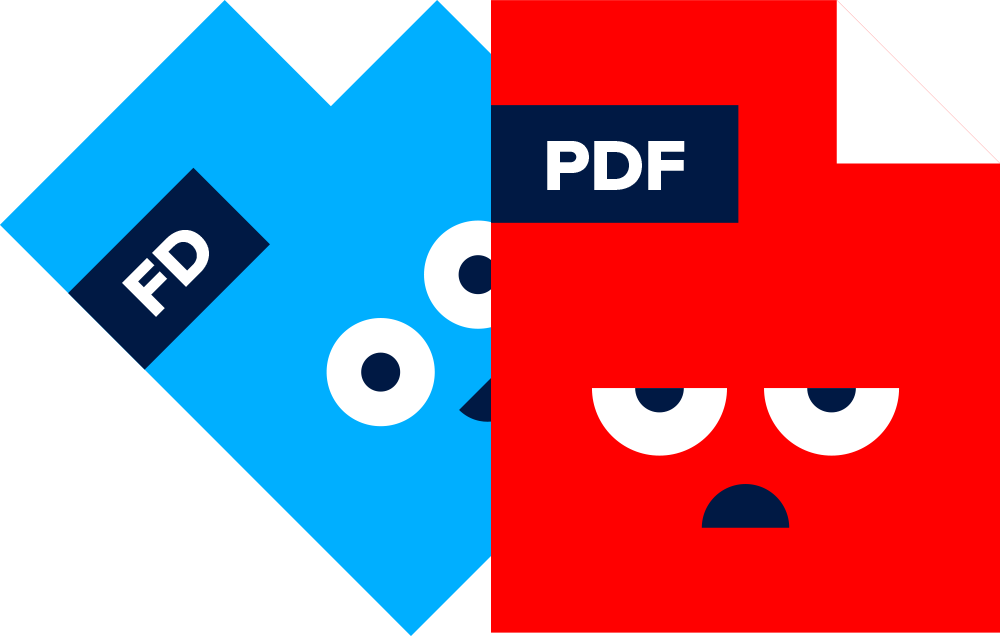Gated content assets like white papers are one of the pillars of digital marketing. Website visitors trade their contact details for your expert knowledge. Not only is this a brilliant way to fill your funnel with leads, but a quality white paper also allows you to position your brand as a thought leader in a given domain.
Unfortunately, marketers have been slow to adapt to the way most people today use websites.
While web developers have adopted mobile-first design to accommodate the vast numbers of visitors browsing the web with mobile devices, producers of white papers continue to use PDFs — a legacy file format from 1993 that is neither responsive nor measurable.
Because PDFs are fixed-layout documents, they are virtually impossible to read on smaller screens. This means that over 50 percent of your visitors (the current estimate of mobile traffic from Statista) are likely to never read your white paper after downloading it.
You may gain leads, but you lose the opportunity to impress and persuade this large segment of visitors — or worse — you set them up for disappointment as they receive a document they can't immediately interact with.
If that's not bad enough, PDFs cannot be tracked or measured. They cannot be improved or optimized based on data, and you lose track of distribution once they've been downloaded. The ability to gather data and make improvements is essential for modern marketing.
Clearly, it’s time to choose an alternative way of presenting white papers — one that takes mobile users into account, allows you to improve your content based on reading behavior, and allows you to keep track of distribution.
The case for web-based interactive white papers
Luckily, a PDF is not the only way to present your content. Using HTML5 and JavaScript, the same technologies that power websites, you can create measurable, mobile-friendly white papers that are far easier for your audience to consume — and are surprisingly easy to make.
Here's why you should never publish a white paper as a PDF again.
Making white papers responsive
Perhaps the most damaging flaw with PDFs, as far as your readers are concerned, is that PDFs aren’t responsive. When was the last time you tried reading a PDF on a phone?

They need to be constantly resized. Readers must pinch, zoom, and pan around. If you’re publishing your white papers as PDFs, you’ll lose a large percentage of your mobile viewers simply due to readability issues.
PDFs don’t work well on smartphones because they were created decades before our modern devices came on the market. When they were invented, they made it possible to retain document layouts across platforms, but today they may prevent your white papers from being read at all.
Web-based interactive white papers, on the other hand, can be responsive in a way that wouldn’t otherwise be possible. Unlike PDFs, which just get smaller as the screen size decreases, these can adapt their layout to whatever device is being used. This ensures they're always readable. Have a look at this responsive white paper from BBN which increased their readership by 300% in 12 months.
White papers that contribute to SEO
Say you had a great content idea. Not just a great idea but a unicorn — it’s interesting, it’s shareable, it aligns perfectly with your ideal customer profile, people will be willing to trade their contact info for it, and you know it will be able to rank on Google.
That is, it would be able to rank on Google if you weren't planning to put it in a gated PDF, inaccessible to web crawlers.
Another advantage of web-based white papers, built-in HTML5, is that you can restrict access to the public while still allowing web crawlers to see and index their contents, thus driving organic traffic.
Authoritative long-form content like white papers do exceptionally well organically because they are full of rich, well-researched information that's likely to answer the search intent of your visitors. When a user clicks through from a search result page to your white paper, they'll need to fill in their details. See this white paper example from AAT.
Creating web-based interactive white papers is the best way to generate leads and contribute to your website's domain authority at the same time.
Improving your white papers based on data
Acquiring leads with gated content is only part of the content marketing process. White papers should also serve to educate, inform, and persuade your prospects regarding the benefits and features of your products and services. They should pull your prospects further through your customer journey.

A basic principle of marketing is that you should always be collecting data about the performance of your content so that you can make it more effective. But in order to apply this to your white papers, you must be able to gather data from them too.
Unfortunately, PDFs make this impossible. You can see how many people came to your landing page and downloaded your white paper, but you won’t have any data from the white paper itself.
Imagine tracking behavioral metrics for each page of your white paper and analyzing precisely which pages, paragraphs, topics, and sections interest your users most (or least). Data gives you the power to optimize your content, make it more persuasive, and ultimately drive more bottom-line results. Using web-based interactive white papers, instead of PDFs, makes this possible.
Don’t settle for just one unicorn when you can utilize data to give readers exactly what they want with every single white paper. Continual improvement means more views, higher quality leads, and more sales.
See the results payroll company Tentoo achieved with measurable white papers.
Create white papers faster
With the complexity of tools like InDesign, producing a high-quality PDF requires lots of time and design expertise. You'll likely need to involve a professional designer — which is a questionable use of resources for a document that only half your intended audience will be able to read.
Even after the white paper design is finished, you'll likely need to involve your development team to get the document on your site, properly gated with the form and download functionality in place, not to mention a way to sync lead information with your CRM.
This delay can be costly. In the time it takes to set it all up, think of how many views and conversions you may be losing.
Tools like Foleon remove all of this hassle, allowing marketers without design or development experience to quickly create web-based white papers using intuitive drag and drop editor. Setting up a gate to capture lead information is as simple as checking a box.
For marketing and communications professionals creating white papers, it’s important to move away from PDFs toward interactive, web-based content because it speeds up the process and frees you from reliance on design and development teams.
Remove the friction
Friction happens when there are too many hurdles your user must jump through before reading your white paper. After working so hard to write, design, and publish your content, the last thing you want is for it to remain unread.
A common mistake with white papers is to create a landing page with a form that's just too intimidating. They say that every additional form field increases your bounce rate by about 10%. If half your users are willing to fill out 2 form fields, only 40% will be willing to fill out 3 fields, and so on.
For those who do make it past the form, there’s typically the extra step of downloading a PDF — or even receiving an email with a link to download the white paper. Every additional step means lost conversions and less engagement.
Gating white papers in this way avoids forms altogether and give you more robust information about your readers. Hosting content online also conveniently eliminates the download process.
Your content deserves better than a PDF
Modern content marketing, especially white paper marketing, involves many steps both for you and your users. As you draw visitors through your funnel, each of those steps represents either a successful touchpoint or a potential hurdle.
Using PDFs weakens your marketing efforts by excluding a large segment of your audience, providing you with little data for improvement, and creating unnecessary friction for potential leads.
For years, Foleon has provided leading brands and agencies with an interactive, responsive, web-based alternative to PDFs. We help marketers move into the 21st century by making their content more effective and easier to create, and thus capture leads that would otherwise be lost.
See some amazing examples of what interactive white papers look like.



